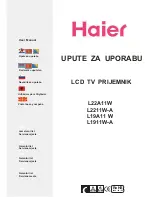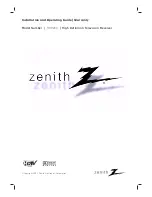
For product recycling instructions and more infor-
mation, please go to http://www.spectrapreci-
sion.com/eng/weee-and-rohs.
Recycling in Europe: To recycle Spectra Precision
WEEE (Waste Electrical and Electronic Equipment
products that run on electric power), call +31 497
53 24 30 and ask for the “WEEE Associate”. Or,
mail a request for recycling instructions to:
Trimble Europe BV
c/o Menlo Worldwide Logistics
Meerheide 45
5521 DZ Eersel, NL
Declaration of Conformity
We, Spectra Precision,
declare under sole responsibility that the product:
SP90m GNSS receiver
complies with Part 15 of FCC Rules.
Operation is subject to the following two condi-
tions:
(1) this device may not cause harmful interference,
(2) and this device must accept any interference
received, including interference that may cause
undesired operation.
Explanations on logos and acronyms found on the
receiver sticker:
: Federal Communication Commission
: Restriction of Hazardous Substances Directive
: Conformité européenne (European Compliance)
: Waste Electrical and Electronic Equipment Directive
IC: Industry Canada
V: Volts
: Direct Current
Rechargeable Lithium-ion Batteries
This receiver uses one rechargeable Lithium-ion
battery.
WARNING
-
Do not damage the rechargeable Lithi-
um-ion batteries. A damaged battery can cause an
explosion or fire, and can result in personal injury
and/or property damage. To prevent injury or dam-
age:
•
Do not use or charge the batteries if they ap-
pear to be damaged. Signs of damage include,
but are not limited to, discoloration, warping,
and leaking battery fluid.
•
Do not expose the batteries to fire, high tem-
perature, or direct sunlight.
•
Do not immerse the batteries in water.
•
Do not use or store the batteries inside a vehi-
cle during hot weather.
•
Do not drop or puncture the batteries.
•
Do not open the batteries or short-circuit their
contacts.
WARNING
-
Avoid contact with a rechargeable Lith-
ium-ion battery if it appears to be leaking. Battery
fluid is corrosive, and contact with it can result in
personal injury and/or property damage. To prevent
injury or damage:
•
If a battery leaks, avoid contact with the bat-
tery fluid.
•
If battery fluid gets into your eyes, immediate-
ly rinse your eyes with clean water and seek
medical attention. Do not rub your eyes!
•
If battery fluid gets onto your skin or clothing,
immediately use clean water to wash off the
battery fluid.
WARNING
-
Charge and use the rechargeable Lith-
ium-ion batteries only in strict accordance with the
instructions. Charging or using the batteries in un-
authorized equipment can cause an explosion or
fire, and can result in personal injury or/and equip-
ment damage. To prevent injury or damage:
•
Do not charge a battery if it appears to be dam-
aged or leaking.
•
USE EXCLUSIVELY the dual-battery charger
(P/N 53018010-SPN) or the AC/DC power
supply (P/N 107000) to charge the SP90m
Lithium-ion battery. See instructions in this
guide. These two devices are part of the
SP90m standard accessories list.
CHARGE THE BATTERIES ONLY IN THE
TEMPERATURE RANGE 0° to +40°C (32° to
104°F), at a maximum altitude of 2,000 me-
ters (6,562 feet).
•
Discontinue charging a battery that gives off
extreme heat or a burning odor.
•
Use the batteries only in Spectra Precision
equipment that is specified to use them.
•
Use the batteries only for their intended use
and according to the instructions in the prod-
uct documentation.
Disposing of the Rechargeable Lithium-ion Battery
Discharge the Lithium-ion battery before disposing
of it. When disposing of the battery, be sure to do
so in an environmentally sensitive manner. Adhere
to any local and national regulations concerning
battery disposal or recycling.
CAUTION
- RISK OF EXPLOSION IF BATTERY IS
REPLACED BY AN INCORRECT TYPE.
DISPOSE OF USED BATTERIES ACCORDING TO
THE INSTRUCTIONS”
ATTENTION
- RISQUE D'EXPLOSION SI LA BAT-
TERIE EST REMPLACÉE PAR UNE BATTERIE DE
TYPE INCORRECT.
METTRE AU REBUT LES BATTERIES USAGÉES
CONFORMÉMENT AUX INSTRUCTIONS.
Receiver Use and Care
The receiver can withstand the rough treatment
that typically occurs in the field. However, the re-
ceiver is a high-precision electronic instrument and
should be treated with reasonable care.
CAUTION
- Operating or storing the receiver out-
side the specified temperature range can damage
it. For more information, see Physical Specifica-
tions in this guide.
High-power signals from a nearby radio or radar
transmitter can overwhelm the receiver circuits.
This does not harm the instrument, but it can pre-
vent the receiver from functioning correctly. Do not
use the receiver within 400 meters (1312 feet) of
powerful radar, television or other transmitters.
Low-power transmitters such as those used in cell
phones and two-way radios do not normally inter-
fere with receiver operations.




































